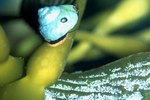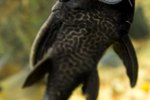
Sea monkeys are real animals, but they aren't real monkeys -- in fact, these tiny creatures are a type of crustacean. They're brine shrimp who got their widely recognizable name thanks to a commercial venture that brought the little animals into the homes of millions. Since the start of their sale as pets in the 1960s, sea monkeys have earned a place in pop culture.
"Sea Monkey" Origins
Brine shrimp have existed in the wild for ages, but they haven't always been sold as pets. In fact, they weren't popular in the household until 1960, when they were "invented" by a scientist named Harold von Braunhut. Von Braunhut did not actually create the species; he discovered that the eggs have a long shelf life out of water. He gave these brine shrimp the name "sea monkeys" and began selling packets of their eggs through the mail, along with powdered food. The marketing, which was targeted primarily to children by advertising in comic books, suggested that these were exotic, almost anthropomorphic creatures, and promised that they came to life almost instantly when placed in water.
The Life Cycle
Brine shrimp are sold in the form of "sea monkeys" because of their unique birthing process. They produce eggs called cysts that can survive for long periods out of water: a cyst can last up to 25 years in the right conditions. Von Braunhut packaged the eggs in a chemical compound he called "Instant-Life Crystals," which helped preserve the eggs in their packaging and make them viable longer. This added to their mystique that made sea monkeys a national sensation. As sea monkeys grow, they go through more than a dozen stages of life, molting between each one. They grow rapidly, though. Despite the number of molts they experience, under the right conditions -- warm temperatures, well-oxygenated water, ample food -- they may reach adulthood in just over a week. Otherwise, it can take up to six weeks.
Brine Shrimp Anatomy
A brine shrimp's anatomy is far less sophisticated than that of most pets. For example, a brine shrimp doesn't have a brain -- just a collection of nerves that dictate when the creature performs bodily functions like eating. He breathes through his feet. He eats algae, so you don't have to clean his tank. Because he's relatively translucent, you can tell by one's color how recently he has eaten.
Caring for Pets
Sea monkeys require little maintenance, another reason for their mail-order popularity. Every few days, they eat a scoop of powdered food that you add to the aquarium -- packets of food come with the cysts. On the occasion that bacteria develops in the tank, you may need to scoop it out or add a medicinal powder to the water to protect the sea monkeys. Other than that, these simple creatures generally take care of themselves.
References
Photo Credits
-
mail box 2 image by marcodeepsub from Fotolia.com
Writer Bio
Tom Ryan is a freelance writer, editor and English tutor. He graduated from the University of Pittsburgh with a degree in English writing, and has also worked as an arts and entertainment reporter with "The Pitt News" and a public relations and advertising copywriter with the Carnegie Library of Pittsburgh.




